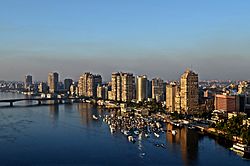Medieval context
The HCRP has issued many plans, which have been met with resistance by some Cairens, the citizens of Cairo. For example, the plans to create gardens and walkways is seen by some as an assault on the original dense medieval layout and 'urban fabric' of Fatimid Cairo that diminishes the historical value of the retained sites.
The reasoning is that in Medieval Cairo, the context of a building was determined by its relationship to neighboring buildings. Buildings and monuments of importance were intentionally constructed adjacent to conventional ones, to convey and enhance their high stature and prestige. It is this urban clustering and juxtaposition that actually gives the landmark buildings authentic context and meaning for visitors to experience. Some Cairens think that by eliminating this context from the buildings the HCRP is lessening the value and historical understanding of their heritage sites. [3]
Some architectural conservation experts have claimed the HCRP has used incorrect building materials in its conservation work. [2] Other conservation experts counter that the massive and immediate intervention for landmarks, despite the inevitable mistakes, has stopped the threat of many just disappearing. [2] [3]



